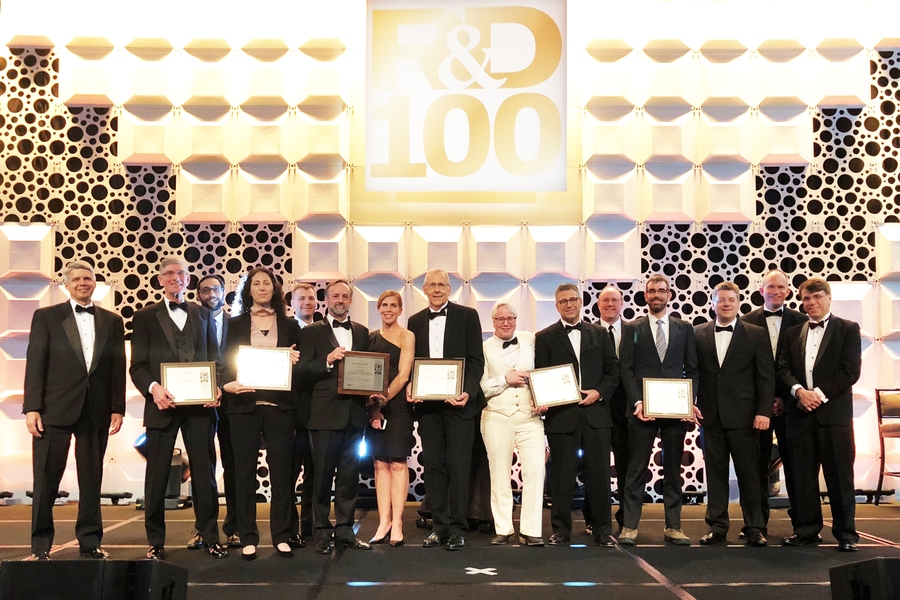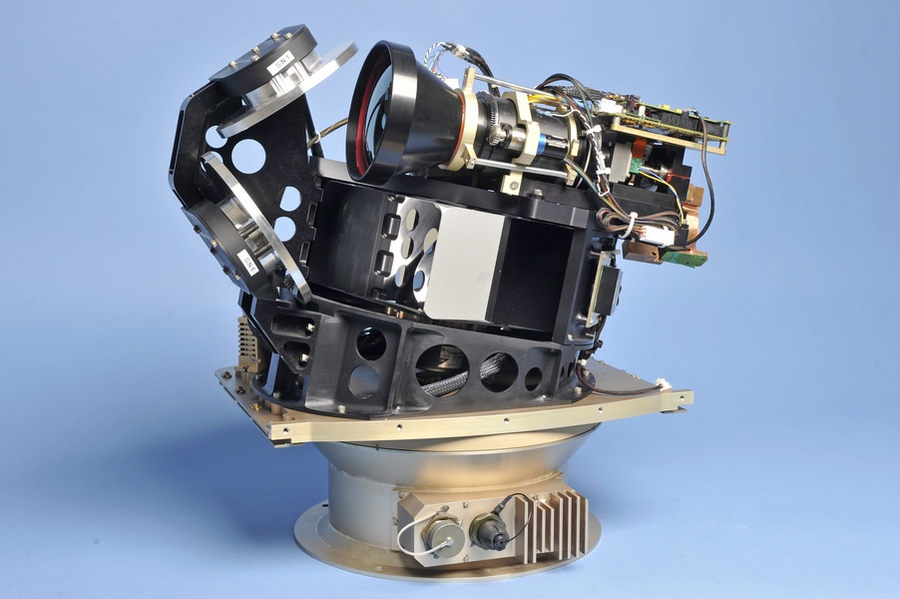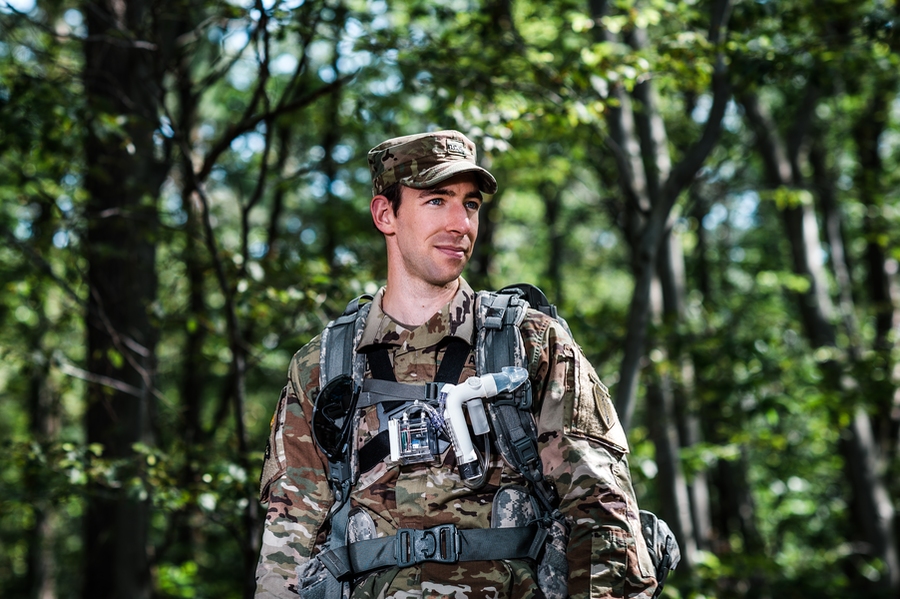R&D 100 Awards have been presented to six technologies that were developed either solely by technical staff from MIT Lincoln Laboratory or through their collaborations with researchers from other organizations. These awards, given annually by R&D Magazine, recognize the 100 most significant inventions introduced in the past year.
A panel composed of R&D Magazine editors and independent reviewers selects the recipients from hundreds of nominees from industry, government laboratories, and university research institutes worldwide. The awards were announced during a banquet at the 2017 R&D 100 Conference last month in Orlando, Florida. The six winning technologies from this year bring to 38 the total number of R&D 100 Awards that Lincoln Laboratory has received since 2010.
Measuring metabolism to guide health decisions
Lincoln Laboratory, in collaboration with the U.S. Army Research Institute of Environmental Medicine and the Marine Expeditionary Rifle Squad, developed a low-cost personal sensor that allows individuals to make on-demand metabolic measurements simply by breathing into the apparatus. The Carbon dioxide/Oxygen Breath and Respiration Analyzer (COBRA) measures the respiratory exchange ratio in exhaled breath (i.e., the ratio of carbon dioxide produced to oxygen consumed) and the volume rate of oxygen consumption. These measurements enable the calculation of both energy expenditure and the levels of carbohydrates and fats burned by the body to meet energy-expenditure demands.
This information about the rate of energy expenditure and the dietary sources of metabolic energy can help military commanders, doctors, physical trainers, and coaches set reasonable standards for physical exertion. For example, limits on the distance and speed of foot marches can be established by quantifying metabolic workloads of soldiers. Clinicians could also use COBRA metabolic data to tailor dietary and exercise regimens for the one-third of Americans who are struggling to manage obesity and avoid the high blood glucose levels that precede the onset of Type 2 diabetes.
"The COBRA system promises to cost-effectively provide RER and energy-expenditure measurements comparable to those provided by clinical sensors costing as much as $40,000, and with ease of use that makes personal ownership feasible," says Gary Shaw, principal investigator on the Laboratory’s COBRA team.
Enabling remotely piloted aircraft to avoid mid-air collisions
Lincoln Laboratory worked with the U.S. Army, SRC Inc., and Kutta Technologies to develop a system that enables remotely piloted aircraft to meet Federal Aviation Administration (FAA) and international standards for seeing and avoiding other aircraft.
The Ground-Based Sense-and-Avoid (GBSAA) System for Unmanned Aircraft Systems (UAS) uses both existing FAA radars to locate transponder-equipped airplanes that communicate with air traffic control personnel and 3-D radars with special processing algorithms to locate general-aviation airplanes that do not carry transponders. The GBSAA system’s purpose-built algorithms process the surveillance data from the various radars to track aircraft and to estimate the risk the remotely piloted systems pose to nearby aircraft; the system then issues warnings and provides maneuver guidance for UAS pilots.
"The key to the system is its logic design that takes into account not only the current location and velocity of each aircraft but also factors in the effects and uncertainties of maneuvers a pilot may make," says Rodney Cole, Lincoln Laboratory's program lead.
Typically for UAS, see-and-avoid regulations are satisfied when their pilots receive actionable information relayed to them by ground observers positioned along the UAS flight path or by a conventional aircraft following the UAS. These surveillance methods can only be used if aircraft are flying in clear skies during daylight, are costly, and limit the efficiency of UAS operations.
Onboard sense-and-avoid systems are yet to be fully developed and could often be too large, heavy, "power-demanding," and expensive to be adopted for use on all but the largest UAS models. The GBSAA system is a reliable, practical alternative that could open up the national airspace to remotely piloted systems potentially well-suited for uses such as making deliveries or conducting search and rescue missions.
Minimizing the ocean’s effect on radar data
Lincoln Laboratory has developed a radar technique for mitigating the effects of clutter caused by the dynamic nature of the ocean's surface. This sea clutter — energy reflected from objects other than those the radar is seeking — is particularly challenging for shipborne and shore-based radar systems, whose electromagnetic energy interacts with the sea surface at near-horizontal angles of incidence. At such low angles, the radar trackers on maritime systems may be inundated by persistent false alarms generated by sea clutter, and objects of interest may go undetected against the clutter background.
Polarimetric Co-location Layering is an algorithm that filters detections to retain object returns while reducing false alarms produced by sea clutter. The algorithm differentiates between objects, whose radar reflections indicate velocities that are consistent in both horizontally and vertically polarized channels, from sea clutter, whose radar reflections indicate velocities that will differ over time for horizontal and vertical polarizations. Thus, radar detections on reflections that are polarimetrically co-located over time are considered to signify the discovery of an object.
"Polarimetric Co-location Layering reduces the rate of false alarms resulting from sea clutter by, on average, two orders of magnitude while retaining nearly all target detections across a range of sea surface conditions, radar bandwidths, and target types," says Molly Crane, the lead developer of the algorithm. "The algorithm has the potential to strongly influence the design of future maritime radar systems."
Early warning of exposure to pathogens
Researchers from Lincoln Laboratory, the U.S. Army Medical Research Institute of Infectious Diseases (USAMRIID), and the National Institutes of Health - Integrated Research Facility (NIH-IRF), developed an algorithm that uses real-time physiological data — such as heart electrical activity (electrocardiography, ECG), breathing rate, and temperature — to predict the probability that a person was exposed to a pathogen, such as a virus or bacteria. Called Presymptomatic Agent Exposure Detection or PRESAGED, the algorithm was designed to run on data collected from noninvasive medical sensors such as wearable heart monitors.
A subject's physiological data are provided to a binary classification machine learning algorithm that has learned both pre- and post-exposure physiological states. The algorithm compares the current data to each of these models, yielding an estimate of whether and when the subject was exposed to a disease-causing pathogen.
PRESAGED was tested with data acquired from non-human primates at USAMRIID and NIH-IRF. The researchers investigated several exposure methods (intramuscular, aerosol, or intratracheal routes) to test for evidence of several viral hemorrhagic fevers, including Ebola virus, or the bacterial pathogen Y. pestis.
The results showed that PRESAGED provided two to three days of early warning of incipient symptoms (such as fever), without regard to the particular virus or bacteria, exposure route, pathogen dose, or animal species. PRESAGED identification of an exposure is available well before that of other diagnostic methods such as blood tests.
"Early detection of oncoming illness could dramatically change the public health measures implemented following a communicable disease outbreak, and could provide a trigger to use life-saving therapeutics when most effective," says Albert Swiston, Lincoln Laboratory's principal investigator in this research sponsored by the Defense Threat Reduction Agency.
Improving radar detection in clutter interference
Lincoln Laboratory researchers developed a technique to suppress signal interference and eliminate the ambiguity in range measurements that is inherent in pulse-Doppler radar. Pulse-Doppler radar is traditionally used to track aircraft and weather because the reflected radar returns can be processed to measure the range and the velocity of a target. However, this measured range is mapped to an ambiguous range span, and wind turbines, ground clutter, and other distant interferers may overlap with the desired target in ambiguous range and impede the radar's ability to detect the target.
The Laboratory's Pulse-to-Pulse Phase Diversity technique utilizes a specialized radar transmit waveform and a tailored chain of signal processing algorithms to filter out interference and eliminate range ambiguity. The technique varies the parameters of the transmit waveform from pulse to pulse, thereby giving unique signatures to radar returns from different range ambiguities. Returns from unwanted range ambiguities are suppressed, producing a clear view of the target that is being tracked.
"Although our work was aimed at suppressing wind turbine interference, this technique can offer direct benefits to radar systems of many types, across diverse mission areas, and for a wide variety of clutter interference, such as ground clutter, sea clutter, and vehicular traffic," says Paul Berestesky, a key developer of the technique.
Providing day and night surveillance
Lincoln Laboratory's Wide-Area Infrared System for Persistent Surveillance (WISP) detects, tracks, and displays on a monitor all moving objects on the ground or in the air surrounding the surveilled location. WISP displays a high-resolution, long-wave infrared, black and white image on which moving objects of interest can be outlined with colored boxes or circles and tracks are denoted by colored lines. The graphical user interface shows WISP's 360-degree panoramic view of a region and is refreshed every second. This interface also allows the user to zoom in on moving objects for a closer look. Because WISP detects thermal emissions not photonic reflections of objects, it can function equally well day or night.
"The WISP sensor uses the laboratory's unique digital-pixel focal plane array technology that enables high-resolution image collection and moving target detection over a hemisphere every second, while filtering out background clutter," says David Klick, a lead researcher on the WISP development. "WISP's combined resolution, sensitivity, coverage, and update rate far exceed those of competing sensors."
Because of its small size, less than 2 feet tall and about 15 inches wide, WISP is easy to transport and can be mounted on towers, tripods, and vehicles. A tower-mounted WISP can provide military bases, critical infrastructure installations, and major outdoor events with real-time, wide-area monitoring of their surroundings. Such up-to-date warning of an approaching danger, detected from far away, gives the system operator extra time to initiate protective measures that counteract the danger, perhaps saving lives.









